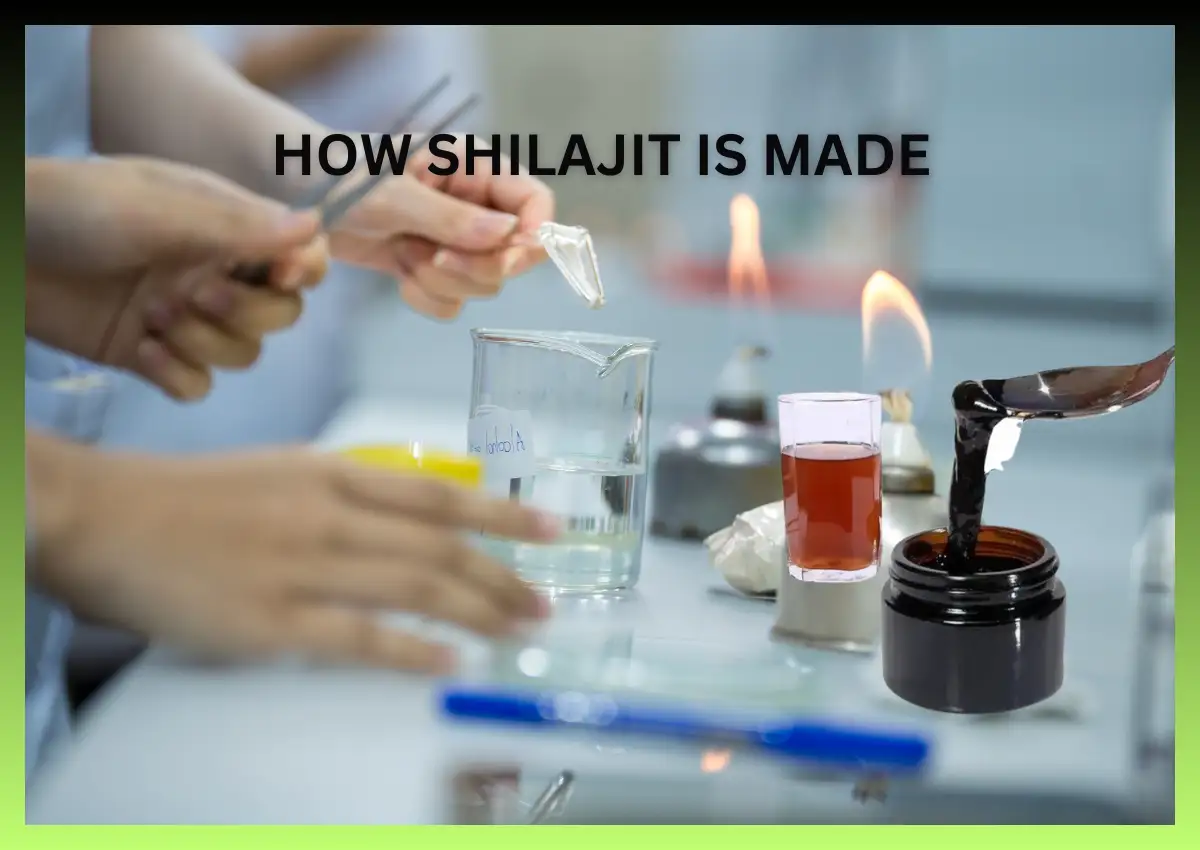What Is Shilajit Made From and Why Does Processing Matter
You’ve probably seen Shilajit being called a powerful natural supplement. But what exactly is shilajit made from?
Shilajit forms slowly over thousands of years from plants, herbs, and minerals that get trapped and decompose between mountain rocks.
Did You Know?
Pure Shilajit conducts electricity due to its ionic mineral content.
These organic materials rot under pressure, heat, and time, turning into a thick, dark, resin-like liquid that seeps out of the rocks in high places like the Himalayas and Altai Mountains.
So when someone asks what Shilajit is made of, the answer is: it’s made from ancient plant remains, minerals from the soil, and natural compounds created by microbes in the mountain environment.
That’s where things get interesting. In its raw form, Shilajit is not ready to use directly. It may look rich and earthy, but it’s also full of things your body doesn’t want, like sand, dirt, harmful bacteria, heavy metals, and other harmful stuff.
This is why raw shilajit processing really matters. If Shilajit isn’t cleaned and purified properly, it can be unsafe or not as effective.
You could be taking something that looks natural but has hardly any real benefit—or worse, something that harms your body.
A good processing method removes the bad parts and keeps the helpful compounds that your body actually needs.
When done right, Shilajit becomes a clean, nutrient-rich substance your body can absorb easily. That’s what makes it worth taking—and what separates real, high-quality Shilajit from the fake or poorly made ones.
What Is The Shilajit Extraction Process
Now that you know what Shilajit is made from, let’s talk about how it’s actually found and collected. The whole process starts high up in the mountains—usually between 10,000 and 16,000 feet above sea level—where the air is thin, the rocks are cold, and the conditions are harsh.
Shilajit doesn’t grow like a plant or get mined like metal. It slowly oozes out of cracks in mountain rocks after years of pressure and heat.
It looks like dark, sticky tar on the surface of the stone. Local workers—usually people who’ve lived in those regions for generations—climb up steep slopes to find these spots.
The raw shilajit is then carefully scraped off by hand.
This is where the “extraction” part happens. But keep in mind, raw Shilajit fresh from the rock is not clean. It often comes with bits of soil, rock dust, and organic waste.
So, before it can be sold or used, it needs to go through a few important steps to remove all those unwanted pieces.
What are traditional shilajit processing methods?
Before modern machines and labs, people of India had their own ways of making Shilajit safe to use.
These traditional methods were simple but smart. And in many parts of the world, especially in the Himalayas, these old techniques are still used today.
The process usually starts by soaking the raw Shilajit in water. This step helps to soften it and separate it from unwanted stuff like sand, dirt, and small stones.
After soaking, the water turns dark—almost black—because the good parts of Shilajit dissolve into it.
Then, the liquid is carefully filtered. In the old days, people used thin cloth or natural mesh to strain it. They’d keep pouring it through again and again to catch anything that didn’t belong.
After filtering, the next step was drying. Most of the time, they let the liquid sit out in the sun for days. This is also called sundry shilajit.
The heat would slowly remove the water, leaving behind a thick paste. This paste was then stored in small clay pots or natural containers and used as medicine.
Even though these methods were basic, they worked. The people doing it understood the land, the mountains, and the nature of Shilajit. They didn’t need fancy machines—they just knew how to work with what nature gave them.
But of course, these methods also had limits, and they were time-consuming. Things like temperature, water quality, and time could affect how clean or strong the final Shilajit turned out. That’s why modern processing became important over time—to get more control over the quality.
Modern Shilajit Processing and Manufacturing Methods
Nowadays, Shilajit isn’t just prepared in villages or mountain huts. It’s made in labs, tested in factories, and sold worldwide.
That means the way it’s processed has changed a lot—and in many ways, improved.
The process still begins the same way: raw Shilajit is collected from mountain rocks. But after that, everything becomes more controlled.
First, the raw Shilajit goes through a water extraction process. It’s soaked in clean, filtered water—usually warm—to break it down.
This helps pull out the useful nutrients while leaving behind things like sand, grit, and heavy metals. Machines stir the mixture regularly so it stays even.
Next comes filtration. But instead of using cloth, manufacturers use advanced filters and lab tools.
Some use mesh screens; others use machines called centrifuges that spin fast to separate clean Shilajit from the rest.
This step helps remove impurities more effectively than the old methods ever could.
After that, the liquid is dried. There are two common ways to do this:
- Vacuum drying, where water is pulled out using low heat and pressure.
- Freeze-drying, which removes water at freezing temperatures to protect nutrients.
Freeze-drying is often considered the best method because it keeps more of the natural minerals and fulvic acid intact. It also avoids damaging the product with high heat.
Also Read: Fulvic Acid vs Shilajit vs Humic Acid: Your Complete Guide
Finally, the dried Shilajit is tested in labs. Good manufacturers check for bacteria, mold, and heavy metals and make sure the mineral levels are just right.
Only after passing all those tests does the Shilajit get packed into resin jars, capsules, powders, or liquid extracts for people to buy.
These modern methods make sure that processed Shilajit is safe, pure, and consistent—something traditional techniques couldn’t always guarantee.
Shilajit Processing Comparison: Traditional vs Modern
By now, you’ve seen that Shilajit can be made using either old-school methods or modern technology. But which one is better? Honestly, both have their pros and cons. It really depends on what you’re looking for—natural authenticity or precise quality control.
Here’s a simple comparison to help you understand the key differences:
| Feature | Traditional Processing | Modern Processing |
| Tools Used | Clay pots, cloth filters, sun drying | Steel tanks, lab filters, vacuum/freezers |
| Water Source | River or spring water | Filtered, purified water |
| Purification Method | Hand filtering, sun exposure | Multi-step filtration, lab-tested |
| Drying Method | Sun-dried (natural but slow) | Vacuum or freeze-dried (faster, cleaner) |
| Time Required | Several days or even weeks | A few hours to a day |
| Control Over Quality | Low—varies by region and weather | High—consistent results, tested in labs |
| Preservation of Nutrients | Good, but depends on climate | Excellent, especially with freeze drying |
| Risk of Contamination | Higher – hard to monitor microbes/metals | Lower – regular testing and clean setup |
| Environmental Impact | Minimal – low tech | Can vary – depends on energy usage |
In short, traditional processing feels more natural and follows ancient wisdom, but it lacks precision. Modern processing gives cleaner, safer results, and is trusted for medical-grade supplements.
If you’re buying Shilajit today, the best option is often a product that respects traditional knowledge but uses modern tools to make sure it’s clean, potent, and safe.
How to Spot Well-Processed and Fake Shilajit
If you’re thinking about trying Shilajit, one of the smartest things you can do is learn how to tell if it’s been processed the right way. Sadly, not every product on the market is real or safe to consume.
Let’s look at what well-processed Shilajit should look like and how to spot the fake or low-quality stuff.
How to Know if Shilajit Is Properly Processed:
- Dissolves in warm water – Real Shilajit should dissolve completely in warm water, leaving little to no residue. It should not float or clump.
- Does not dissolve in oil – If it blends into oil, that’s a red flag. Real Shilajit won’t.
- No gritty or sandy texture – It should feel smooth when you rub a small amount between your fingers.
- No strong chemical smell – A clean, earthy smell is normal. If it smells like rubber or chemicals, it’s likely fake.
- Lab-tested and certified – Reputable brands will provide lab reports showing the product is free from heavy metals, mold, and bacteria.
- Comes in airtight, sealed packaging – Open containers or weak packaging can allow moisture or bacteria to spoil the product.
- Do an alcohol solubility test: Authentic Shilajit won’t dissolve in alcohol.
- Pliability test: Genuine Shilajit is pliable when warm and hard when cold.
- Flame Test: Pure Shilajit bubbles and releases an earthy scent without burning when heated on a spoon.
- Texture Test: Genuine Shilajit is sticky and tar-like at room temperature, hardens when cooled, and softens into resin when warmed—unlike fake ones that are too hard or too runny.
- Mouth Test: Place a small piece of Shilajit on your tongue—if it tastes bitter and is hard to swallow, it’s likely pure; an easy-to-drink or sweet taste may indicate fillers or additives.
- Viscosity Test: Take a small piece of Shilajit on your finger and place it under running water—if it washes away instantly, it’s likely fake; real Shilajit dissolves slowly and steadily.
Warning Signs of Fake or Poor-Quality Shilajit:
- It’s too shiny, like plastic or tar.
- It has a sweet or artificial smell.
- The label has no ingredients, no test results, or no company info.
- It’s too cheap to be true—real Shilajit is rare and not easy to collect or process.
If a product looks suspicious or doesn’t pass these simple checks, it’s better to avoid it. Poorly processed Shilajit might not give you any benefit, or worse, it could be harmful.
You may like: How to Spot Fake Shilajit – 7 Signs You Shouldn’t Ignore
Which Shilajit Process Is Best?
If you’re trying to decide between traditionally made Shilajit and the kind that’s processed in a lab, you might be wondering—what’s actually better for your health?
The short answer: a mix of both is ideal.
Traditional methods do a good job of respecting nature. They follow ancient ways passed down over generations, and they don’t involve chemicals or artificial steps.
That’s great if you care about how natural your supplement is.
But modern processing brings something just as important to the table: cleanliness, safety, and consistency.
Machines can remove tiny particles that humans can’t. Labs can test for heavy metals and make sure the product meets international health standards.
You also get better shelf life and exact measurements.
So the best Shilajit products today usually come from brands that:
- Source raw Shilajit from high-altitude regions like the Himalayas
- Use modern filtering and drying methods (like freeze drying)
- Test every batch for safety
- Still honor the traditional approach by keeping it free of synthetic additives
If you find a brand that does all of this, you’re probably looking at a product that’s safe, effective, and as close to nature as possible.
Shilajit by Region: Himalayan vs Mumie (Altai Shilajit)
Not all Shilajit comes from the same place. The two most well-known types are Himalayan Shilajit and Mumie (also spelled Mumijo), which is mostly found in the Altai Mountains and other parts of Central Asia and Eastern Europe.
Also Read: Siberian shilajit vs Himalayan shilajit vs Altai shilajit
Himalayan Shilajit comes from the high-altitude rocks of the Himalayas in India and Nepal. It’s usually darker, stickier, and has a higher content of fulvic acid and trace minerals.
It’s also considered to be the oldest and most potent form. Traditionally, locals collect it by hand, sun-dry it, and purify it using spring water.
Today, high-quality Himalayan Shilajit is often lab-purified using gentle water filtration and freeze-drying methods.
Mumie, on the other hand, is found in the Altai, Caucasus, and even parts of Iran, Russia, and Mongolia. It’s very similar to Shilajit in how it’s formed, but it may have slightly different mineral content depending on the region.
In some areas, it’s processed using older methods like boiling or heating, which can reduce its potency.
The best modern producers now apply controlled drying and filtration to keep it clean and effective.
Conclusion
I hope I am able to make you understand how shilajit is made. Shilajit is a powerful natural resin formed over centuries, but its true value depends on proper purification.
While traditional methods preserve ancient wisdom, modern processing ensures safety, purity, and potency.
For the best results, choose lab-tested Shilajit made with clean water extraction and advanced drying techniques. Please let us know your feedback in the comments section below.
Frequently Asked Questions
1. What is Shilajit made from?
Shilajit is made from ancient plant matter and minerals that have broken down over hundreds of years inside mountain rocks.
2. How is Shilajit processed traditionally?
Traditionally, Shilajit is soaked in water, filtered through cloth, and then dried in the sun. These methods are natural and simple, but they can’t always remove harmful impurities completely.
3. What is modern Shilajit processing?
Modern processing uses filtered water, stainless steel containers, advanced filters, vacuum or freeze drying, and lab testing.
4. Is freeze-dried Shilajit better?
Yes, freeze-drying keeps the heat-sensitive nutrients in Shilajit intact. It helps preserve more of its natural strength compared to sun-drying or boiling.
5. Can heating damage Shilajit?
Yes. If Shilajit is processed at high heat for too long, it may lose some of its nutrients and become less effective. That’s why low-heat or no-heat methods are preferred.
6. How can I test if Shilajit is real?
Dissolve a small amount in warm water. It should mix completely without leaving grit or foam. It should not smell like chemicals or look shiny like plastic.
7. What’s the safest type of Shilajit to use?
Look for lab-tested, purified shilajit from a trusted source. Resin is often preferred for purity, but powder and capsules are fine if processed correctly.
References:
- https://www.bookogs.com/book/189418-taina-drevnego-balzama-mumiio-asil
- http://www.ccras.nic.in/sites/default/files/viewpdf/jimh/JIMH_2010/13%20to%2024.pdf
- https://shilajit-resin.com/shilajit_in_the_history/
- https://www.twirpx.com/file/1482523/
- http://nlam.in/ing_disp.php?s=28dd2c7955ce926456240b2ff0100bde&i=045117b0e0a11a242b9765e79cbf113f
- https://historyws.blogspot.com/2014/08/facts-about-shilajeet-or-shilajit-or.html
- https://books.google.com/books?id=88bSCQAAQBAJ
- https://www.twirpx.com/file/1482523/
- http://www.ruskniga.com/mumie-mify-i-real-nost.html
- http://therdsf.org/wp-content/uploads/2014/06/shilijitNEW-1.pdf
- https://www.ncbi.nlm.nih.gov/pmc/articles/PMC3609271/
- https://www.shd.org.rs/JSCS/Vol75/No3/14_4376_3974.pdf
- http://www.ipacom.com/index.php/en/full-and-water/fullerenes
- https://www.ncbi.nlm.nih.gov/pubmed/24409811
- https://www.researchgate.net/publication/289163756_Fullerene-DBP_conjugates_Their_co-occurrence_in_meteorites_ammonites_and_Shilajit_and_application_in_systemic_drug_delivery
- http://www.lifeextension.com/Magazine/2009/SS/Coenzyme-Q10-Technology/Page-01
- https://www.ncbi.nlm.nih.gov/pmc/articles/PMC3139983/
- https://www.ncbi.nlm.nih.gov/pmc/articles/PMC3758058/
- https://www.researchgate.net/profile/Ramesh_Gupta10/publication/279746105_Anti-Inflammatory_and_Anti-Arthritic_Efficacy_and_Safety_of_Purified_Shilajit_in_Moderately_Arthritic_Dogs/links/559bff9d08ae7f3eb4cee827.pdf
- https://www.ncbi.nlm.nih.gov/pubmed/2345464/
- https://www.ncbi.nlm.nih.gov/pmc/articles/PMC6190247/
- https://www.researchgate.net/publication/51086923_Review_on_shilajit_used_in_traditional_Indian_medicine
- https://www.ncbi.nlm.nih.gov/pmc/articles/PMC3215318/
- https://www.ncbi.nlm.nih.gov/pmc/articles/PMC2876922/
Disclaimer
This article is for informational purposes only. Please consult a licensed healthcare provider before starting any new supplement, especially if you are pregnant, breastfeeding, or on medication.



